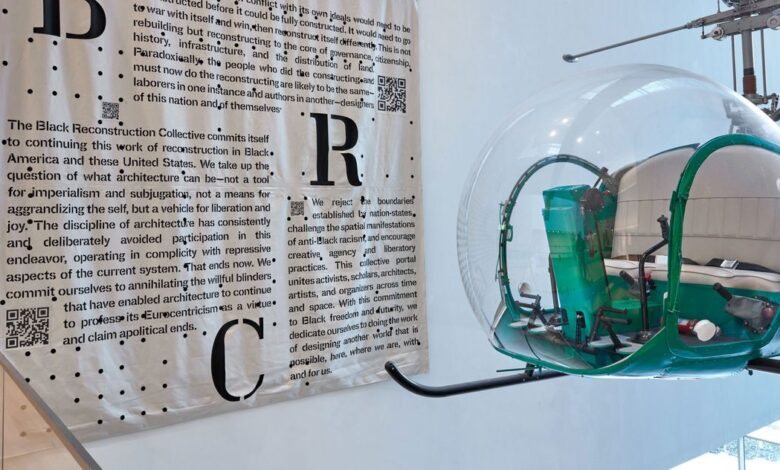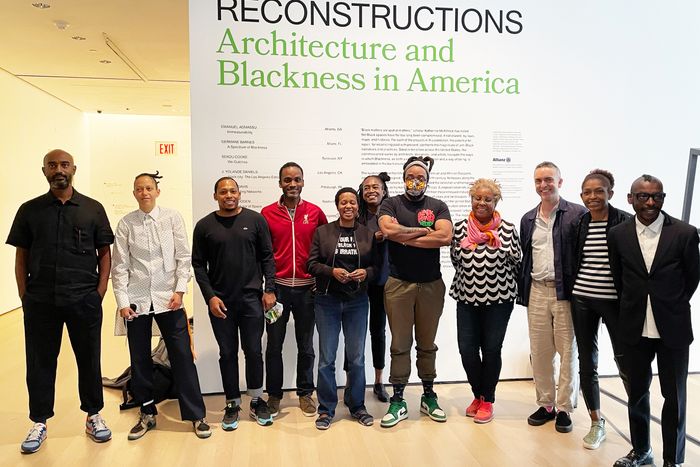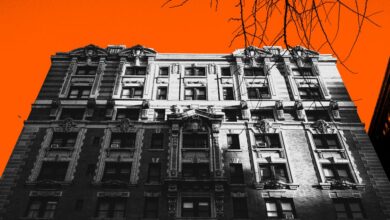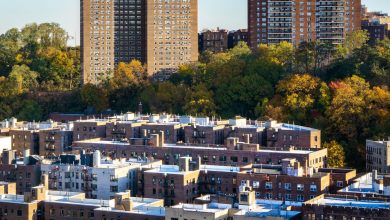The Black Reconstruction Collective, After MoMA


Photo: Robert Gerhardt, Courtesy ofThe Museum of Modern Art
When the ten designers in MoMA’s “Reconstructions: Architecture and Blackness” exhibition got together for the first time in 2019 to meet with the curatorial team of Mabel O. Wilson, Sean Anderson, and Arièle Dionne-Krosnick, they heard a presentation by Saidiya Hartman and Tina Campt on the practice of refusal. The two scholars theorize that the rejection of any structure that fails to recognize a Black person’s humanity or subjectivity is a source of power and creative possibility. This is the concept behind their Practicing Refusal Collective, a Black feminist forum they founded to discuss futurity, Blackness, and anti-Black racism.
“All of us were really blown away,” says Mario Gooden, one of the architects in the exhibition. “What stuck was this need not to be disciplined, not to be legible. That it’s okay to be undisciplined because the disciplinary practices of architecture have always been exclusive and have always fallen into certain tropes of what Blackness is: Blackness as a disorder, Blackness as poverty, Blackness as somehow ‘other.’”
Afterward, the ten — Emanuel Admassu, Germane Barnes, Sekou Cooke, J. Yolande Daniels, Felecia Davis, Mario Gooden, Walter J. Hood, Olalekan Jeyifous, V. Mitch McEwen, and Amanda Williams — decamped to a nearby hotel, where the show’s out-of-town participants were staying, and compared notes about what they had heard. “I just remember the feeling of: Make this particular audience or this institution or whomever come to you,” says Jeyifous. “[It was this] inclination to never diminish or soften or make palatable the kind of way I’m working.”
The concept of practicing refusal opened the door for the most consequential project of the exhibition: the formation of the Black Reconstruction Collective, which the participants founded soon after that September meeting to support one another. It also shifted the artists away from the expectations that come with exhibiting in an institution like MoMA, which has had an outsize influence on modern architecture and has long excluded the work of Black architects. “When I left [the meeting], I realized that the fear of going into the institution started to disappear,” said Cooke. “They need me. I’m the one in the seat of power. And I get to produce the work that I think needs to be produced in the way that I want to produce it — and relentlessly demand that they support it in the way that they need to support it.” With the formation of the BRC, the designers not only reoriented how this particular exhibition would be mounted but also created something that would live on beyond the show: an infrastructure to support the autonomy of Black designers, architects, and artists. Ultimately, the story of the BRC is about creating the space necessary to reimagine the practice of architecture itself.
From left: Emanuel Admassu, V. Mitch McEwen, Germane Barnes, Sekou Cooke, Amanda Williams, Felecia Davis, Olalekan Jeyifous, Mabel O. Wilson, Sean Anderson, J. Yolande Daniels, and Mario Gooden.
Photo: Lyla Catellier
Reconstructions, which ended in May, was the first show on Black architects and race in the Architecture and Design department’s 89-year history. There haven’t been many major museum exhibitions dedicated to Black spatial practices in general. The last New York exhibition on the subject was “Harlemworld: Metropolis as Metaphor,” curated by Thelma Golden at the Studio Museum in 2004. The MoMA architecture exhibitions that did take place during those nine decades promoted practices that harmed Black communities, especially in the 1960s and ’70s, when urban renewal was a popular planning strategy — the 1967 exhibition “The New City: Architecture and Urban Renewal” advocated for the demolition of primarily Black urban communities, and in 1973, “Another Chance for Housing: Low-Rise Alternatives” featured mostly white architects proposing solutions for Black neighborhoods in New York City. This history is coupled with a lack of Black architects in the museum’s collection: The first work by a Black designer to enter the Architecture and Design permanent collection was accessioned in 2016: a 1962 model of Charles Harrison’s View-Master.
The exhibition, which takes its name from a W.E.B. Du Bois essay about reconstruction in America, situated itself as a continuation in the larger project of liberation for Black people. But to do that within architecture — a very Eurocentric discipline — required new framing. This also meant veering away from the problem-solving ideology of the profession and the museum’s own conventions. “Reconstructions” is the latest show in MoMA’s “Issues in Contemporary Architecture” series, which commissions architects and designers to offer spatial solutions to problems in the built environment, like climate change, the affordable housing crisis, and urban sprawl. But the curators of “Reconstructions” wanted to upend the typical solutions-oriented structure of the past.
They convened a multidisciplinary advisory committee of people with backgrounds in critical theory, feminist theory, history, art history, performance, African diaspora studies, and architecture who served as a living archive for the exhibit, helped select the ten architects, and consulted with them as they worked on their commissions. “It became clear that this was not going to be a show where Black people have to solve their own oppression; to ask that would be insulting. And the participants agreed,” Wilson says.
The BRC’s first collective action took place when the designers returned their contracts to MoMA in late 2019. They struck a line about fundraising limitations and emailed their individual contracts back at the exact same time.
“We were a little bit nervous about saying ‘we are this collective, and we’ve done this thing on the side, and we haven’t been telling you,’” Cooke says. “But when we told Sean and Mabel [Wilson], they were absolutely thrilled.”
Wilson also had a question: What are you going to leverage? The artists thought of a longer horizon, beyond the show itself. “Thinking of the Thelma Golden show, we can’t allow 17 years to pass before we have a platform for the conversations that we have been having within and among ourselves for many years,” Jeyifous says.
They asked themselves, “How do we work to support one another intellectually, spiritually, and financially and leverage this moment not only for ourselves, but for future artists, architects, and designers?” Gooden says.
While collectives in architecture aren’t new, among Black architects, they’re almost a precondition to achieving creative freedom and thriving professionally. Projects like Blackspace, a group of Black urbanists advocating for preserving and creating Black spaces; Design as Protest, organizers of the design justice movement; and Dark Matter University, a network of educators working to democratize design teaching with anti-racist principles, have gathered hundreds of designers together to address longstanding racial inequity in the field.
As the designers grappled with the theoretical and intellectual work of preparing their commissions, they also struggled with the blunt financial limitations they faced. The MoMA contract only offered an $8,000 stipend to each artist. Although some participants assumed that there would be another stipend for research and fabrication, that wasn’t the case. Everyone quickly learned that the museum expects firms to absorb any additional costs. The only other resources that MoMA provided were basic exhibition services: printing for graphic elements, framing, packing, crating, and shipping.
“The opportunity presented to architects and designers having work in MoMA is how valuable it is, not in terms of financial currency, but in cultural currency,” says Brad Samuels, an architect who participated in the 2016 “Uneven Growth” exhibition at the museum. For that show, MoMA commissioned six projects from six teams, which were each composed of two architecture studios. Each studio received a $7,500 stipend. Samuels estimated that his firm put in about $50,000 worth of labor.
“We’re all aware of what the transaction is,” Samuels says. “You’re paid shit and you get a large stage to put your ideas into the world. We were aware of what we were spending. We had arguments internally about why we spent that. It worked the way we expected and grew our practice.”
This is also reflective of the field in general — low pay and long hours in exchange for cultural cache. Larger architecture firms have budgets to enter competitions and participate in exhibitions, and often have staff to dedicate to this work. But newer and emerging practices don’t have this cushion, and neither do many Black-led firms.
“It’s assumed that we will just do whatever it takes and spend whatever it takes to get it done, even if the commission isn’t commensurate with the labor — that somehow architects will work for free,” Gooden says. “Most Black architects don’t have those advantages.”
Gooden himself wanted to build something full-scale for the show. His project, The Refusal of Space, includes a three-dimensional structure titled Protest Machine, which was inspired by the first Black-owned streetcar line in Nashville. Mounted with multiple video screens projecting footage from historic demonstrations, it connects the way protesters from the Civil Rights era and the Black Lives Matter movement have used space to fight for their liberation. For materials and fabrication alone, Gooden estimated the cost to be at least $30,000. When Sean Anderson asked him what it would take to create the work he wanted, Gooden told him $120,000, which included paying for research assistants, fabrication, and materials costs. “I think it really blew his head off,” Gooden says.
And yet, Gooden, who is also an associate professor at Columbia, was one of the participants with relatively more access to resources. Among the participants in “Reconstructions,” Walter Hood and Gooden have the largest firms, with 15 and 6 people, respectively. They, along with several other participants, also had affiliations with academic institutions and could go to them for additional funding or student research assistance. But the solo practitioners who don’t teach — like Jeyifous and Williams, who operate more like artists and pursue grants and commissions — couldn’t call upon these resources.
“I spent a lot of money, and I just stopped tallying it,” Jeyifous says. The project he developed for the show, The Frozen Neighborhoods, is a speculative work that imagines Crown Heights after a climate-change disaster. To present his vision of a neighborhood cut off from the world and sustained through new technologies created by residents, he created digital renderings and an animated video and also fabricated physical artifacts — including a hacked subway kiosk and vegetable-seed stands — that seemed plucked from that world.
Just two months before the show was set to open, Jeyifous almost let go of the idea of getting the kiosk custom-fabricated. “I was like, I’m just gonna buy a commercial mailbox, build it in my kitchen, and figure it out,” he says. He let this story slip to his friend Larry Ossei-Mensah, an art-world curator who is also on the board of Onassis Commissions, who was able to give him an $8,000 grant to build the kiosk.
“The impetus for the collective is not just ‘Let’s raise some money to cover our projects,’ which was part of it at the beginning,” Sekou Cooke says. His project, We Outchea, explores the cycle of displacement and development in the 15th Ward in Syracuse, which was razed for the construction of the I-81 highway in the 1950s. “But how do we stop other Black architects from having to go through this exact [experience] in the future?” Cooke continues. “If another show like this happens in some parallel universe, how can we actually write somebody a check?”
Their conversations extended beyond compensation for their labor to the question of how their labor benefits the institution itself. The BRC is adamant that it’s not their responsibility to repair MoMA’s history of systemic racism, just as the premise of the exhibition was that Black artists did not have to design solutions to their own oppression.
“There is a history of extraction of labor within architecture, but given the last year, in terms of the social-justice reckoning, this show is now in that context, and it just kind of points to the further extraction of Black labor,” Gooden says. “So it is this group of ten artists, architects, and designers who are doing the work that the museum should have done before. In the wake of this, people are saying, ‘MoMA is putting on this show about architecture in Blackness in America.’ But no, that’s not the case; this is our labor that’s being exploited, to be quite frank about it.”
While the budget for “Reconstructions” (about $547,000) was higher than previous shows in the series (the budgets for previous shows were between $50,000 and $157,000), this reflects a bigger scope in the number of artists, since previous shows only involved five to six commissions and this show doubled that number. (“This is a complicated topic, and we wanted more than five voices in the gallery,” Wilson, one of the co-curators, explained. The curators also commissioned an original work from the photographer David Hartt, who isn’t part of the BRC.)
For the BRC, beyond the individual commission fees, what they really wanted to see at MoMA was an institutional commitment to redress its long record of exclusion. The collective suggested the museum collect more work from Black architects and launch a program to study race and architecture, something along the lines of the $10 million architecture and ecology institute MoMA announced last December. But the museum did not respond to these proposals.
“Whether or not MoMA supplied adequate support for producing the show’s material is irrelevant,” the BRC told Curbed. “We gave them a clear opportunity and invitation to step up to the challenge that this moment in time demanded. They had an opportunity to go down in history as partners in a rapidly forming movement. The fact that they’re talking about frames when we’re talking about changing the world is all anyone needs to know.”
A ten-foot-long fabric banner of unbleached cotton-denim fabric was hung at the threshold to “Reconstructions.” For visitors to the exhibition, the Manifesting Textile foregrounds the projects they’ll see within the gallery — speculative fictions, resurfaced histories of Black communities, a diasporic kitchen, and design theory inspired by the Black Panther Party’s Ten-Point Program. It also plots a course for the BRC’s larger project within architecture: “We take up the question of what architecture can be — not a tool for imperialism and subjugation, not a means for aggrandizing the self, but a vehicle for liberation and joy,” the banner reads. “With this commitment to Black freedom and futurity, we dedicate ourselves to doing the work of designing another world that is possible, here, where we are, with and for us.”
Since the exhibition opened, the BRC has been busy hosting talks, lectures, and roundtable discussions about issues like environmental justice, the architecture of Black futures, and what the architecture of reparations might look like. Any speaking fee or honorarium it receives is pooled into the nonprofit it formed last summer. The BRC redistributed the initial speaking fees to members of the collective who needed it to complete their projects. In the future, the BRC plans to issue grants to other Black spatial practitioners and is currently looking for an executive director and expects to begin its first grant cycle this fall.
“We’ve seen immediate support from some of the nation’s leading philanthropic and development communities,” the BRC says. “We are serious about building new institutions to exist in the new worlds and new ways of being we posited in the exhibition. We had an inaugural strategic planning retreat last weekend to that end and are excited about our future.”
Multiple institutions have expressed interest in acquiring individual work from the show, and the artists are in the process of choosing where they would like their projects to eventually live. Not all of the BRC members feel strongly about seeing their work in MoMA’s collections. “MoMA has historically had the role as the keeper of the canon,” Gooden says. “But I don’t think that’s necessarily the case anymore. It’s not the end-all and be-all.”
“Reconstructions,” which closed on May 31, was only open for 13 weeks — about half as long as other architecture shows in the series. Despite calls to extend the run, including an open letter from Dark Matter University, the museum chose not to. “We have actively explored a number of options for the exhibition’s continuation, but unfortunately, given the challenges of the global pandemic, the subsequent closure last year, and the ongoing impacts to the long-term exhibition schedule, it is not possible to extend the exhibition beyond May 31,” a MoMA spokesperson said. “MoMA offered expanded visitor hours during the final weeks of the exhibition and is committed to ensuring that the important ideas generated by the participants will continue to reach audiences through the exhibition’s publication and digital resources.”
Looking ahead, the “Reconstructions” participants can’t help but see some symbolism in the next exhibition scheduled for the architecture galleries: “Automania,” a show on automotive design and culture, which will run for six months. As Jeyifous recently tweeted: ”It is SO ironic how our show, shortest of its kind by half, will be replaced by one on cars: Automania. A veritable [highway] plowing thru the show like many thru Black hoods in every major US city.”





